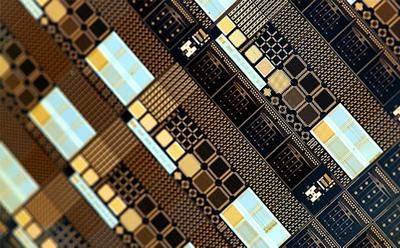Here’s why quantum computing represents the future for investment managers, analysts and traders on the buy-side and the sell-side.
http://news.efinancialcareers.com/us-en/245138/pit-traders/
Here’s why quantum computing represents the future for investment managers, analysts and traders on the buy-side and the sell-side.
http://news.efinancialcareers.com/us-en/245138/pit-traders/
The unparalleled possibilities of quantum computers are currently still limited because information exchange between the bits in such computers is difficult, especially over larger distances. FOM workgroup leader Lieven Vandersypen and his colleagues within the QuTech research centre and the Kavli Institute for Nanosciences (Delft University of Technology) have succeeded for the first time in enabling two non-neighbouring quantum bits in the form of electron spins in semiconductors to communicate with each other. They publish their research on 10 October in Nature Nanotechnology.
Information exchange is something that we scarcely think about these days. People constantly communicate via e-mails, mobile messaging applications and phone calls. Technically, it is the bits in those various devices that talk to each other. “For a normal computer, this poses absolutely no problem,” says professor Lieven Vandersypen. “However, for the quantum computer – which is potentially much faster than the current computers – that information exchange between quantum bits is very complex, especially over long distances.”

Mediating with quantum dots Artist impression of two electron spins that talk to each other via a ‘quantum mediator’. The two electrons are each trapped in a semiconductor nanostructure (quantum dot). The two spins interact, and this interaction is mediated by a third, empty quantum dot in the middle. In the future, coupling over larger distances can be achieved using other objects in between to mediate the interaction. This will allow researchers to create two-dimensional networks of coupled spins, that act as quantum bits in a future quantum computer. Copyright: Tremani/TU Delft.
Researchers at the University of Melbourne have developed a way to radically miniaturise a Magnetic Resonance Imaging (MRI) machine using atomic-scale quantum computer technology.
Capable of imaging the structure of a single bio-molecule, the new system would overcome significant technological challenges and provide an important new tool for biotechnology and drug discovery.
The work was published today in Nature Communications, and was led by Prof Lloyd Hollenberg at the University of Melbourne, working closely with researchers at the ARC Centre of Excellence for Quantum Computation and Communication Technology (CQC2T) to design the quantum molecular microscope.
For the first time, a new tool developed at the Department of Energy’s (DOE’s) Lawrence Berkeley National Laboratory (Berkeley Lab) allows researchers to interactively explore the hierarchical processes that happen in the brain when it is resting or performing tasks. Scientists also hope that the tool can shed some light on how neurological diseases like Alzheimer’s spread throughout the brain.
Created in conjunction with computer scientists at University of California, Davis (UC Davis) and with input from neuroscientists at UC San Francisco (UCSF), the software, called Brain Modulyzer, combines multiple coordinated views of functional magnetic resonance imaging (fMRI) data — like heat maps, node link diagrams and anatomical views — to provide context for brain connectivity data.
“The tool provides a novel framework of visualization and new interaction techniques that explore the brain connectivity at various hierarchical levels. This method allows researchers to explore multipart observations that have not been looked at before,” says Sugeerth Murugesan, who co-led the development of Brain Modulyzer. He is currently a graduate student researcher at Berkeley Lab and a PhD candidate at UC Davis.
Researchers at Sapience.org foresee market instability intensifying by the computer trading ‘arms race’
FOR IMMEDIATE RELEASE
Last Friday the sterling has experienced a dramatic, ultrafast crash. It lost 10% of its value in minutes after the Asian markets opened — a decline usually reserved to declarations of war, major earthquakes and global catastrophes — and bounced right back. Although the affected exchanges are yet to release the details, computer trading algorithms almost certainly played a key role. Just like the 2010 Flash Crash, yesterday’s event is characteristic to Ultrafast Extreme Events[1]: split-second spikes in trade caused by ever smarter algorithms razor-focused on making ever-quicker profits. But the arms race is only likely to intensify as computing speed accelerates and AI algorithms become more intelligent.
RED PILL!!!!
The hypothesis that we might all be living in a computer simulation has gotten so popular among Silicon Valley’s tech elites that two billionaires are now apparently pouring money into breaking us out of the simulation.
That’s according to a new profile in the New Yorker about Y Combinator’s Sam Altman. The story delves into Altman’s life and successes at the helm of the famous boot-camp and investment fund for tech startups, and doesn’t shy away from the quirkier aspects of Altman’s character.
In the piece, Altman discusses his theories about being controlled by technology and delves into the simulation hypothesis, which is the idea that human beings are unwittingly just the characters in someone else’s computer simulation.
Neural Nanonics here we come: “Could lead to future autonomous, fully implantable neuroprosthetic devices”

A bio-inspired electronic device called a memristor could allow for real-time processing of neuronal signals (spiking events), new research led by the University of Southampton has demonstrated.
The research could lead to using multi-electrode array implants for detecting spikes in the brain’s electrical signals from more than 1,000 recording channels to help treat neurological conditions, without requiring expensive, high-bandwidth, bulky systems for processing data. The research could lead to future autonomous, fully implantable neuroprosthetic devices.
Scientists have succeeded in creating the world’s smallest transistor, producing a switch with a working 1-nanometre gate. If you want to know how incredibly tiny that is, a human hair is around 80,000 to 100,000 nanometres wide.
Unlike regular transistors, the researchers’ new prototype isn’t made out of silicon – and the smaller size means we can still improve performance in integrated circuits by populating them with greater amounts of incredibly small components.
And it could help us keep Moore’s Law alive too.